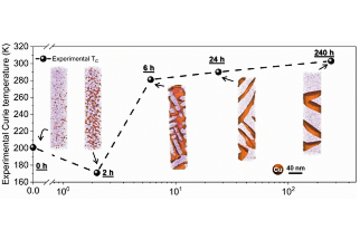All genres
941.
Thesis - PhD
Investigation of interface properties of barrier metals on dielectric substrates. Dissertation, Department of Physical Metallurgy and Materials Testing, Montanuniversität Leoben, Franz-Josef Strasse 18, 8700, Leoben, Austria (2014)
942.
Thesis - PhD
Plasticity and fatigue of miniaturized Cu structures. Dissertation, Department of Physical Metallurgy and Materials Testing, Montanuniversität Leoben, Franz-Josef Strasse 18, 8700, Leoben, Austria (2014)
943.
Thesis - Master
Synthesis and Characterization of Reactive Magnetron Sputtered Fe1−xO Thin Films. Master, HHU Düsseldorf (2023)
944.
Thesis - Master
Solidification and precipitated structure of Al20CoxCr20Fe35Ni20-xTi5 (x = 0, 10, 20) compositionally complex alloys. Master, Heinrich-Heine-Universität Düsseldorf (2021)
945.
Thesis - Master
Microstructure Evolution in FCC Metals during Friction. Master, Heinrich-Heine-Universität Düsseldorf (2019)
946.
Other
Organization of symposium "Metals and Alloys" at Microscopy Conference 2024. (2024)
947.
Other
Preventing Hydrogen Embrittlement: The Role of Barrier Coatings for the Hydrogen Economy, Hydrogen 4 (2 Ed.), pp. 307 - 322 (2023)
948.
Other
Organization of symposium "Metals and Alloys" at Microscopy Conference 2023. (2023)
949.
Other
Organizer of the "Mini-symposium Experimental Micromechanics and Nanomechanics" at the ESMC2022. (2022)
950.
Other
Organizer of the "BiGmax Workshop 2022 on Big-Data-Driven Materials Science". (2022)
951.
Other
Nanobrücken 2020: A Nanomechanical Testing Conference (Organization). (2020)
952.
Other
"International Workshop on Advanced and In-situ Microscopies of Functional Nanomaterials and Devices" IAMNano 2019 (Organization). (2019)
953.
Other
Organizer of the “IAMNano 2019 Düsseldorf” - International Workshop on Advanced In Situ Microscopies of Functional Nanomaterials and Devices. (2019)
954.
Other
DPG Frühjahrstagung: Topical session (EPS & AGMM): Mechanical Properties at Small Scales (Organization). (2019)
955.
Other
Organizer of Mechanical Properties and Adhesion” 46th International Conference on Metallurgical Coatings & Thin Films (ICMCTF) 2019. (accepted)
956.
Other
Acting Chair for the Gordon Research Conference “Thin Film & Small Scale Mechanical Behavior”. (2018)
957.
Other
Mini-symposium “Experimental Micromechanics and Nanomechanics” at the 10th European Solid Mechanics Conference (ESMC2018) (Organization). (2018)
958.
Other
Organizer of Mechanical Properties and Adhesion” 45th International Conference on Metallurgical Coatings & Thin Films (ICMCTF) 2018. (2018)
959.
Other
Organization of "Opening symposium for advanced (S)TEM and APT facilities at MPIE". (2018)
960.
Other
Organizer of Mechanical Properties and Adhesion” 44th International Conference on Metallurgical Coatings & Thin Films (ICMCTF) 2017. (2017)











